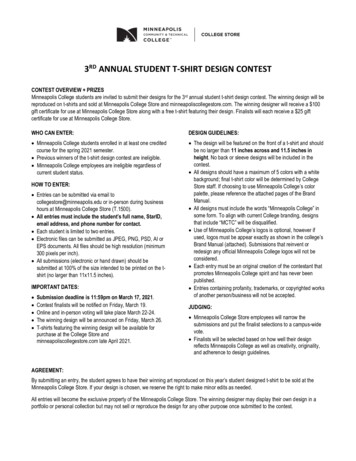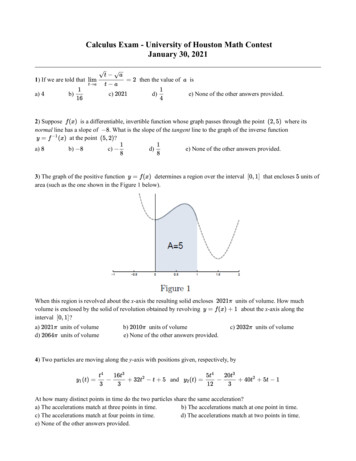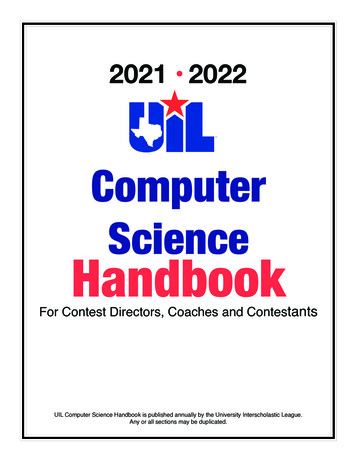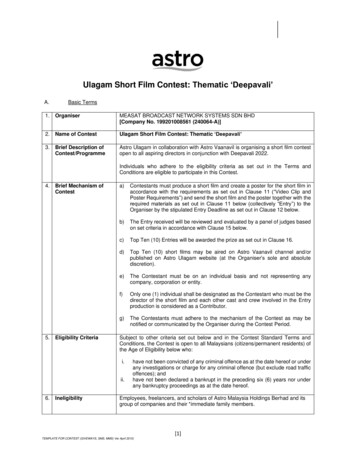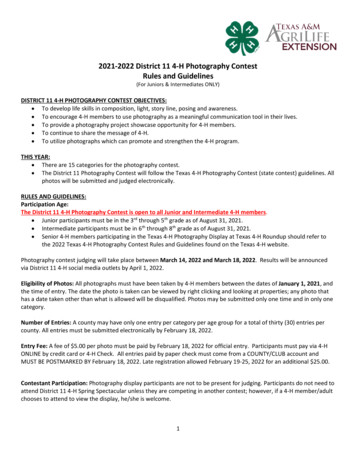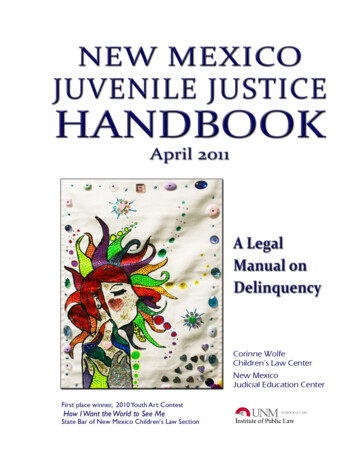
Transcription
Annual Art ContestThe Children’s Law Section of the State Bar of New Mexico sponsors an annual art andwriting contest for youth who are involved in New Mexico’s juvenile justice system. Thecontest allows court-involved youth to communicate ideas and emotions through artand writing, fosters thought and discussion among youth on how to change their livesfor the better, and provides a positive opportunity to express their struggles, look toward the future, and celebrate artistic effort. In 2010, youth were asked to create canvasbanners based on the theme How I Want the World to See Me.
NEW MEXICOJUVENILE JUSTICE HANDBOOKA LEGAL MANUAL ON DELINQUENCYApril 2011With selected updates through July 2011A PROJECT OFTHE CORINNE WOLFE CHILDREN’S LAW CENTER AND THE NEW MEXICO JUDICIALEDUCATION CENTER AT THE INSTITUTE OF PUBLIC LAW, UNIVERSITY OF NEW MEXICOSCHOOL OF LAWTHE DEVELOPMENT OF THIS HANDBOOK WAS MADE POSSIBLE THROUGH A GRANTFROM THE NEW MEXICO JUVENILE JUSTICE ADVISORY COMMITTEE
New Mexico Juvenile Justice Handbook 2011 by the Institute of Public Law, University of New Mexico School of LawInstitute of Public LawMSC11 60601 University of New MexicoAlbuquerque, NM 87131-0001Ph: (505) 277-5006Fax: (505) 277-7064This handbook is intended for educational and informational purposes only. The book is not intended toprovide legal advice and readers are responsible for consulting the statutes, rules and cases pertinent tothe proceeding in which they are involved or the issue they are addressing. Readers must also keep inmind that recent years have seen substantial changes in the laws and procedures governing proceedingsunder the New Mexico Children’s Code and that both law and procedure continue to change.
SUMMARY OF CONTENTSAcknowledgementsIntroduction to the HandbookDetailed Table of ContentsPART A: OVERVIEW1.2.3.Overview of the Juvenile Delinquency Legal SystemRights of the ChildKey ConceptsPART B: ROLES AND RESPONSIBILITIES4.5.6.7.8.9.10.Children’s Court AttorneyDefense CounselParents, Guardians and Guardians ad LitemJuvenile Probation Officers (JPOs)VictimsSpecial MastersJuvenile Public Safety Advisory BoardPART C: PROCEEDINGS UNDER THE DELINQUENCY ACT11.12.13.14.15.16.17.18.19.20.21.Jurisdiction, Transfer and VenuePetitionTaking into Custody; DetentionInitial ProceedingsNon-Adjudicatory ResolutionsAdjudicatory HearingsDispositional HearingsJuvenile DispositionsPost-Disposition ProceduresYouthful Offender ProceedingsAppealsPART D: EVIDENTIARY AND PROCEDURAL ISSUES22.23.24.25.Parties; InterventionDiscovery and DisclosureEvidenceInsanity, Lack of Capacity, Alibi and Entrapment DefensesSUMMARY OF CONTENTSApril 2011
PART E: COMPETENCY AND MENTAL HEALTH ISSUES26.27.Competency to Stand TrialChildren’s Mental Health and Developmental Disabilities ActPART F: CONFIDENTIALITY AND SEALING28.29.Confidentiality of Juvenile RecordsSealing of RecordsPART G: RELATED PROCEEDINGS AND MATTERS30.31.32.33.Problem-Solving Courts and Other ProgramsSex Offender RegistrationStatus OffensesInterstate Compact on JuvenilesPART H: FEDERAL AND TRIBAL CONSIDERATIONS34.35.Federal Laws and JurisdictionTribal Table of StatutesTable of CasesResource DirectorySUMMARY OF CONTENTSApril 2011
ACKNOWLEDGEMENTSThe Handbook is a joint publication of the Corinne Wolfe Children’s Law Center and theRozier E. Sanchez Judicial Education Center, both centers within the Institute of Public Lawat the University of New Mexico School of Law. Most importantly, it is the first projectsponsored by the new Children’s Court Judges Association. The initial directors of theAssociation, Judges Abigail Aragon, Gary Clingman, Camille Martinez Olguin, HenryQuintero, Freddie Romero, John J. Romero, and Monica Zamora, have all been tremendouslysupportive of the Handbook and its development.Intended originally as a judicial benchbook, the judges themselves requested that the book becalled a Handbook and made available to attorneys, probation officers and other members ofthe juvenile justice community as well as to the judiciary. This approach, indeed, the entireeffort to develop a juvenile justice handbook, has been supported fully by Supreme CourtJustice Petra Jimenez Maes, who has made publication of the Handbook a priority.Funding for the Handbook was provided by the Children’s Law Center, the JudicialEducation Center and, through CYFD, the Juvenile Justice Advisory Committee. TheHandbook will be available on the website of the Children’s Law Center:http://childlaw.unm.edu/.The Handbook was developed under the supervision of Judy Flynn-O’Brien, director of theCorinne Wolfe Children’s Law Center until her retirement from UNM in 2011. LeighBrunner, Hon. Michael Martinez, and Lisa Abeyta served as lead writers, editors andreviewers, together with Ms. Flynn-O’Brien. Ms. Brunner is an on-call senior attorney withthe Institute of Public Law, Judge Michael Martinez (ret.) was a long time Children’s CourtJudge in the Second Judicial District and more recently a juvenile prosecutor in theThirteenth, and Ms. Abeyta was a juvenile defender for several years.A number of judges, prosecutors, public defenders, probation officials, other juvenile justiceprofessionals and law students have given generously of their time in reviewing the publicreview draft, making comments, suggestions and corrections, and contributing furtherinformation. In addition to the directors of the judges’ association, these individuals include:Dale DoddTara FordTodd HeiseyJudge Gary JeffreysTheodosia JohnsonRebecca KreinerTed LovatoJessica MartinMichal MokrynNancy NearySarah PiltchRory RankMichael SousaTerry StorchDeborah VarolLinda YenLast but not least, two individuals who provided leadership for the project were DavidSchmidt, who as chair of JJAC provided encouragement and support to the JudgesAssociation and the Children’s Law Center as they developed the Handbook, and GerriDupree, Juvenile Justice Specialist with Youth and Family Services, who served as theCYFD project manager.ACKNOWLEDGMENTSApril 2011
INTRODUCTION TO THE HANDBOOKPurpose of the HandbookThe purpose of the New Mexico Juvenile Justice Handbook is to provide the judiciary andmembers of the juvenile justice community with a comprehensive resource guide to juvenilejustice proceedings in New Mexico’s Children’s Court. While designed and written primarilyfor judges, the Handbook can be used by other participants in the legal system.The Handbook incorporates the applicable requirements of the Delinquency Act and relatedarticles of the Children’s Code, the Children’s Court rules, court cases and federal laws. Itdescribes the judicial process, describes the roles and responsibilities of certain key participants,explains the hearings that may take place in a case, and addresses related topics, such asevidence, defenses, competency, and confidentiality.The Handbook is intended to serve as a current, convenient secondary source of law, policy andpractice for juvenile justice cases in the legal system. Do not rely on the Handbook as legalauthority; instead, consult primary sources for specific legal language and requirements.OrganizationThe Handbook is organized into eight general parts, each divided into chapters addressing thefollowing topics:Part A: Overview Overview of the juvenile justice legal process.Substantive and procedural rights of respondent children.Key concepts involved in the process.Part B: Roles and Responsibilities Roles and responsibilities of certain participants, including the children’s court attorney,defense counsel, the child’s parents, and the juvenile probation office.Note that judges and children are the subject of the entire Handbook and hence are notthe subject of individual chapters in this part.Part C: Proceedings under the Delinquency Act Proceedings are in sequential order of their occurrence, from commencement of a casethrough appeal.Chapters cover issues such as custody, petitions, timelines, jury trials, standard of proof,and other substantive and procedural matters.INTRODUCTIONApril 2011Page 1
Delinquency and youthful offender cases will be described and distinguished. In the caseof youthful offender proceedings, the notice of intent to seek adult sanctions and theprocedures triggered by the notice of intent are covered.Covered in a limited way are serious youthful offender proceedings, that is, first degreemurder cases against children age 15 – 17, the only cases in New Mexico in whichchildren are tried as adults.Part D: Evidentiary and Procedural Issues Intervention, discovery and evidence.Raising defenses such as insanity and specific intent, as well as alibi and entrapment.Part E: Competency and Mental Health Issues Competency to stand trial.Children’s Mental Health and Developmental Disabilities Act.Part F: Confidentiality and Sealing Confidentiality and disclosure in delinquency cases.Sealing of records.Part G: Related Proceedings and Matters Problem-solving courts and court programs.Status offenses in New Mexico.Sex offender registration.Interstate Compact on Juveniles.Part H: Federal and Tribal Considerations Federal laws affecting state proceedings, including the Juvenile Justice and DelinquencyPrevention Act.Federal offenses and how children are handled in the federal system.Tribal jurisdiction and tribal-state relations.In addition, the Handbook contains appendices which include common acronyms, a glossary ofterms used in the Children’s Code, and lists of statutes and cases cited in the text. Alsoimportant is the Resource Directory, which contains lists of probation offices, county juveniledetention centers, community corrections, juvenile justice continuum sites, and other resources.INTRODUCTIONApril 2011Page 2
Style and FormatThe Handbook is written in narrative form, with every effort being made to achieve a balancebetween readability and accuracy in areas that are complex and governed by detailed statutes,rules and cases. Abbreviations are used but should be readily recognizable when encountered.Citations to statutes, rules and cases use the most concise style possible while still providingadequate reference information. Full citations can be found in the statute and case lists in theappendices. In general, citations in the text use the following style: Statutes: New Mexico statutes are cited as § - - , such as §32A-4-1, without“NMSA 1978.” Federal laws are cited as U.S.C. § , such as 25 U.S.C. §1901.Rules: New Mexico judicial rules are cited as Rule - , such as Rule 10-201, withoutthe addition of “NMRA.”Cases: New Mexico cases are cited using the vendor-neutral citation adopted in 1998,such as 2004-NMCA-039, if available, or the New Mexico and regional reportercitations, such as 116 N.M. 793, 867 P.2d 1175 (1994) if the case predates the use ofvendor-neutral citations. Complete citations may be found in Appendix D, the Table ofCases.It is important for attorneys to note that the form of citation in this Handbook is for the sake ofbrevity and formatting and is not necessarily appropriate for formal citations in briefs. Refer tothe Supreme Court General Rules, specifically Rule 23-112 NMRA, for the proper form ofcitation for pleadings and papers filed with the courts.Availability of Laws and CasesWhile the Handbook contains citations to numerous state and federal statutes, rules and cases, itdoes not provide their full text. You can find these legal materials in law libraries and throughthe Internet. Some examples of no-cost electronic sources are listed below.Statutes and Court Rules and Forms New Mexico statutes/court rules/forms: http://www.nmcompcomm.us Federal statutes: http://www.gpoaccess.gov/uscodeAgency Rules New Mexico Administrative Code: http://www.nmcpr.state.nm.us/nmac/ Federal regulations: http://www.gpoaccess.gov/cfr/INTRODUCTIONApril 2011Page 3
Cases New Mexico appellate cases: http://www.nmcompcomm.us Federal cases: http://www.findlaw.com/casecode/Effective DateThe Handbook is generally current through April 2011. As funds and staffing allow, theHandbook will be updated periodically. Please contact us at the address below for informationabout the status and availability of updates.Additional CopiesFor information on purchasing copies of the Handbook, please contact the Corinne WolfeChildren’s Law Center at the address below. The Handbook is also available free of charge onthe Center’s website, http://childlaw.unm.edu. Users are welcome to print a copy of theHandbook for their convenience.Permission to ReproduceFor information on the permission and acknowledgements necessary for reproducing portions ofthe Handbook, please contact the Corinne Wolfe Children’s Law Center at the address below.ContactFor further information on the Handbook, or to report errors or suggestions for future updates,please contact:Beth Gillia, Center DirectorPh: 505-277-0710Fax: 505-277-7064Email: bgillia@unm.eduTracey Kincaid, CoordinatorPh: 505-277-9170Fax: 505-277-5483Email: tkincaid@unm.eduCorinne Wolfe Children’s Law CenterSchool of Law, Institute of Public LawMSC11 60601 University of New MexicoAlbuquerque, NM pril 2011Page 4
NEW MEXICO JUVENILE JUSTICE HANDBOOKTABLE OF CONTENTSSummary of ContentsAcknowledgementsIntroduction to the HandbookPART A: OVERVIEW1.Overview of the Juvenile Delinquency Legal System1.1.The Children’s Code and the Delinquency Act1.2.Children's Court in New Mexico1.2.1.Appointment of Children’s Court Judges1.2.2.Summary of Children’s Court Jurisdiction1.3.Brief History of Delinquency Law1.3.1.Parens Patriae and the Establishment of Children’s Courts1.3.2.In re Gault1.3.3.Expansion of Due Process Rights1.3.4.Adult Sentencing of Juveniles1.4.Anatomy of a Delinquency y Hearing1.4.4.Disposition1.5.Terminology Applicable to Delinquency Proceedings1.6.Timeline for the Proceeding1.7.Graphic Illustration of Process2.Rights of the Child2.1.Overview2.2.Assistance of Counsel2.2.1.Federal Constitution2.2.2.State Law2.3.Privilege Against Self-Incrimination2.3.1.Federal Constitution2.3.2.State Law2.4.Search and Seizure and the Exclusionary Rule2.4.1.Unreasonable Search and Seizure2.4.2.Exclusionary Rule2.5.Advisement of Rights2.6.Allocution2.7.Pre-Trial Detention and Bail2.8.Trial by Jury2.8.1.Federal ConstitutionTABLE OF CONTENTSApril 2011Page 1
2.8.2.State Law2.9.Confrontation Clause2.10. Proof Beyond Reasonable Doubt2.11. Right Not to Be Tried While Incompetent2.12. Speedy Trial2.13. Double Jeopardy2.14. Death Penalty and Life Sentences2.15. Appeal and Habeas Corpus3.Key Concepts3.1.Goals of Delinquency Act3.1.1.Non-Criminal Nature of Delinquency Proceedings3.1.2.Delinquency Act’s Emphasis on Rehabilitation3.1.3.Public Interest and Safety3.1.4.Role of Brain Science in Recent Delinquency Jurisprudence3.2.Disproportionate Minority Contact3.3.Gender Responsiveness3.4.Juvenile Detention Alternatives Initiative3.5.Cambiar New Mexico3.6.Juvenile Delinquency Guidelines for JudgesPART B: ROLES AND RESPONSIBILITIES4.Children’s Court Attorney4.1.Overview4.2.Structure4.3.General Duties4.4.Initiation and Termination of Delinquency Proceedings4.5.Representing the State in Preliminary Proceedings4.6.Disclosure of Information and Continuing Duty to Disclose4.7.Adult Sanctions for Youthful Offenders4.8.Involuntary Placement and Competency Issues4.9.Role After Entry of Judgment4.10. Sealing of Records4.11. Obligations Under Victims of Crime Act5.Defense Counsel5.1.Public Defender Department5.2.Child’s Right to Counsel5.2.1.Appointment5.2.2.Right to Effective Assistance of Counsel5.2.3.Possible Conflicts of Interest5.2.4.Non-English Speaking Clients5.2.5.Standard of Review5.2.6.Court’s Role in Protecting Child’s Due Process Rights and AssuringEffective Assistance of CounselTABLE OF CONTENTSApril 2011Page 2
5.3.5.4.5.5.5.6.Traditional Attorney-Client Model of RepresentationDuties of Child’s AttorneyChild with Diminished Capacity5.5.1.Rule 16-114 of the Rules of Professional Conduct5.5.2.Authorized Actions to Protect a Client with Diminished CapacityResources for Defense Counsel6.Parents, Guardians, and Guardians ad 3.Guardian ad Litem6.2.Roles and Responsibilities of Parents/Guardians6.2.1.Participation in Treatment6.2.2.Mental Examination6.2.3.Payment of Costs of Institutionalization6.2.4.Fines6.2.5.Costs of Representation6.2.6.Other Responsibilities6.3.Rights of Parents7.Juvenile Probation Officers (JPOs)7.1.Overview7.2.Preliminary Inquiry7.3.Pre-Petition Diversions7.4. Indian Children7.5. Intake and Detention7.5.1.Probable Cause Determination7.5.2.Detention Hearing7.6.Time Waivers7.7.Juvenile Dispositions7.7.1.Pre-Disposition Studies and Reports7.7.2.Client Family Baseline pervised Release7.8.Compliance Monitoring7.9.Probation and Supervised Release Violations7.10. Termination of Probation or Supervised Release7.11. Sealing of Records7.12. Truancy tim’s RightsTABLE OF CONTENTSApril 2011Page 3
8.4.8.5.8.6.8.7.Victim’s RepresentativeResponsibilities of DA and CourtResponsibilities of Parole, Corrections and CYFDVictim Restitution9.Special ons and Removal9.4.Scope of Duties9.5. Recommendations9.6.Timeframes10.Juvenile Public Safety Advisory Board10.1. Creation of the Board10.2. Composition; Attached to CYFD10.3. Powers and Duties of the Board10.4. Assessments of Child, Administrative Reviews, and Reports10.5. Court and CYFD Review of Release DecisionsPART C: PROCEEDINGS UNDER THE DELINQUENCY ACT11.Jurisdiction, Transfer, and Venue11.1. Children’s Court Jurisdiction11.1.1. Children’s Court11.1.2. Delinquent Child11.1.3. Delinquent Act11.1.4. Acts Not Subject to Children’s Court Jurisdiction11.1.5. Three Categories of Cases11.2. Concept of Transfer11.2.1. Requirements of Transfer11.2.2. Transfer Under Prior Law11.3. Venue12.Petition12.1. Complaint or Referral12.2. Preliminary Inquiry12.2.1. Purpose12.2.2. Timeline and Notice12.2.3. Discrepancy Between Time Limits in the Code and Rules12.2.4. Advisement of Rights12.2.5. Topics12.3. Pre-Petition Informal Resolutions12.4. Referral to Children’s Court Attorney12.5. Review by Children’s Court Attorney12.5.1. Legal SufficiencyTABLE OF CONTENTSApril 2011Page 4
12.15.12.16.12.17.13.12.5.2. Best Interest of Public and Child12.5.3. Timeframes for Filing PetitionGeneral Form and ContentParties12.7.1. Basic Parties12.7.2. Joinder12.7.3. SeveranceInterventionJoinder of OffensesMultiple PetitionsStatement of Probable CauseIn Need of Care or RehabilitationAmendmentAssignment of Judge upon Filing of PetitionSummons12.15.1. Required12.15.2. Contents12.15.3. ServiceNotice of PetitionAppointment of CounselTaking into Custody; Detention13.1. Overview13.2. Arrest13.2.1. Warrantless Arrests13.2.2. Arrest Warrants13.3. Failure to Appear Upon Written Promise13.4. Violation of Probation or Supervised Release; Threat of Leaving Court’sJurisdiction13.5. Release from Custody or Delivery to a Place of Detention13.6. Criteria for Detention13.6.1. Interview13.6.2. Risk Assessment Tool13.6.3. Probable Cause13.7. Release from Detention13.8. Notice of Detention13.9. Detention Hearing13.9.1. Purpose; Notice Required13.9.2. Timeline13.9.3. Participants13.9.4. Public Access to Hearings13.9.5. Appointment of Counsel, Guardians, and Guardians ad Litem13.9.6. Electronic Hearings13.9.7. Advisement of Rights13.9.8. Criteria for Detention13.9.9. Denial of ReleaseTABLE OF CONTENTSApril 2011Page 5
13.9.10. Conditional Release13.10. Places of Detention13.10.1. CYFD Licensing of Detention Facilities13.10.2. Type of Facility13.11. Detention Hearing Checklist14.Initial Proceedings14.1. Overview14.2. First Appearance Hearing14.3. Indigency Determination14.4. Delinquency or Youthful Offender Proceeding?14.4.1. Types of Proceedings14.4.2. Initial Procedures When Notice of Intent Filed14.4.3. Preliminary Examinations14.4.4. Grand Jury Proceedings14.4.5. Arraignments14.4.6. Required Inquiries and Disclosures14.4.7. Record of Proceedings14.4.8. Bail and Conditions of Release14.5. First Appearance Checklist15.Non-Adjudicatory Resolutions15.1. Pre-Petition Diversionary Programs15.2. Time Waivers15.3. Plea Agreements and Consent Decrees15.3.1. Generally15.3.2. Required Inquiries and Disclosures15.3.3. Requirements of Plea Agreements15.3.4. Consent Decrees15.4. Withdrawal of Plea15.5. Waiver of Defects and Rights; Appeals16.Adjudicatory Hearings16.1. Purpose16.2. Time Limits16.2.1. Time Limit for a Child in Detention16.2.2. Time Limit for a Child Not in Detention16.2.3. Justification for Time Frames16.2.4. Extensions of Time16.2.5. Multiple Petitions16.3. Initiation and Notice16.4. Participants16.4.1. Parties; Transport Order16.4.2. Public Access; News Media; Closed HearingsTABLE OF CONTENTSApril 2011Page 6
16.5.Conduct of Hearing16.5.1. Generally16.5.2. Right to Trial By Jury Unless Affirmatively Waived16.5.3. Record of Proceedings; Preservation of Error16.5.4. Applicable Rules16.5.5. Order of Trial16.5.6. Oral Instructions After Jury is Sworn and Before Opening Statements16.5.7. Use of Jury Instructions in Children’s Court Proceedings16.5.8. Burden of Proof16.5.9. Judgment and Findings16.5.10. Judgment Rendered in Open Court16.6. Checklist for Adjudicatory Hearing17.Dispositional Hearings17.1. Purpose17.2. Timeline17.2.1. Commencement Within 30 Days17.2.2. Commencement Within 45 Days if Child Committed For Diagnosis17.2.3. Verified Petition for Extension of Time17.2.4. Remedy for Failure to Comply with Time Limits17.2.5. Conclusion of Dispositional Hearing and Right to Speedy Trial17.3. Youthful Offender Proceedings17.4. Initiation and Notice; Notice to Victims17.5. Participants17.5.1. Parties17.5.2. Public Access; News Media17.6. Pre-Disposition Reports and Evaluations17.6.1. Discretionary Reports17.6.2. Client Family Baseline Assessment17.6.3. Mandatory Reports17.6.4. Mental Health Evaluation17.6.5. Commitment of Adjudicated Delinquent Child for Diagnosis17.6.6. Examination of a Child’s Parent or Custodian17.7. Evidence; Determination by Judge17.8. Amenability Hearing for Youthful Offenders17.9. Judgments17.9.1. Timing17.9.2. Contents17.9.3. Findings17.9.4. Abuse and Neglect Findings17.9.5. Indian Children17.9.6. Parental Responsibility17.10. Advising Child of Right to Appeal17.11. Corrections and Modifications of Judgment17.11.1. Correction of Judgment17.11.2. Motion to Modify or ReconsiderTABLE OF CONTENTSApril 2011Page 7
17.11.3. Timeline17.11.4. Procedure17.12. Dispositional Hearing Checklist18.Juvenile Dispositions18.1. Overview18.2. Fines and Restitution18.3. Commitment18.3.1. Term of Commitment18.3.2. Juvenile Community Corrections18.3.3. Jurisdiction to Determine Placement18.3.4. Providing Notice and Opportunity to Be Heard to CYFD18.3.5. Transfer of Information Pertinent to Care of Child18.4. Probation18.4.1. Generally18.4.2. Probation Conditions18.4.3. Authorized Probation Conditions18.4.4. Limitations on Probation Conditions18.4.5. Criteria for Reviewing Probation Conditions18.5. Commitment for 15 Days or Less18.6. Special Dispositions18.6.1. Dispositions for Drug and Alcohol Related Offenses18.6.2. Mandatory Disposition for Graffiti Offenses18.7. Limitations on Juvenile Judgments and Dispositions18.7.1. Incarceration with Adult Offenders Prohibited18.7.2. Consecutive Commitments Prohibited18.8. Corrections and Modifications of Judgments18.9. Effect of Juvenile Disposition19.Post-Disposition Procedures19.1. Commitments19.1.1. Court’s Jurisdiction to Extend Juvenile Commitment19.1.2. Court’s Authority to Extend Commitment and CYFD’s Authority toGrant Early Release19.1.3. Procedure for Extending Commitment19.1.4. Standard for Extending Commitment19.2. Probation as Result of Adjudication or Consent Decree19.2.1. Extension of Probation19.2.2. Extension of Consent Decree19.2.3. Early Release From Probation or Supervision19.3. Revocation of Probation or Consent Decree19.3.1. Petitions; No Preliminary Inquiry Necessary19.3.2. Timeline19.3.3. No Jury19.3.4. Taking a Child into Custody and Detention19.3.5. Burden of ProofTABLE OF CONTENTSApril 2011Page 8
19.3.6. Evidence19.3.7. Double Jeopardy19.3.8. Contempt Power as Alternative to Probation Revocation19.3.9. Judgments19.4. Supervised Release19.4.1. Summary19.4.2. 2009 Amendments and Retroactive Application19.4.3. Supervised Release Required19.4.4. CYFD’s Role in Supervised Release Decisions19.4.5. Juvenile Public Safety Advisory Board19.4.6. Supervised Release Revocation19.5. Probation Revocation Hearing Checklist20.Youthful Offender Proceedings20.1.Overview20.2.Definitions20.2.1. Youthful Offenders20.2.2. Serious Youthful Offender20.3.Notice of Intent to Invoke Adult Sanctions20.4.Pre-Trial Detention for Alleged Youthful Offenders20.5.Plea Bargaining Youthful Offenders20.6.Applicable Procedures20.7.Time Limits for Commencement of Trial20.8.Amenability Hearing20.8.1. Purpose20.8.2. Procedures for Amenability Hearing20.8.3. Legal Standard for Imposing Adult Sanctions20.8.4. Eligibility for Involuntary Commitment20.9.Procedure for Imposing Juvenile Dispositions20.10.Procedure for Imposing an Adult Sentence on a Juvenile20.10.1. Sentencing Hearing20.10.2. Requirements for Sex Offenders20.10.3. Responsibilities to Victims20.11.Non-Capital Felonies20.11.1. Basic Sentence for Non-Capital Felonies20.11.2. Alteration of Basic Sentence for Non-Capital Felonies20.11.3. Enhancements to Basic Sentence for Non-Capital Felonies20.11.4. Submission of Firearms Issues to Jury for Non-Capital Felonies20.11.5. Habitual Offenders20.12.Capital Felonies Under Criminal Sentencing Act20.13.Crimes Not Covered Under Code20.14Credit for Time Served20.15.Parole20.16.Effect of Judgment Imposing Adult Sentence20.17.Dispositions in Serious Youthful Offender Cases20.18.Serious Youthful Offenders and AppealsTABLE OF CONTENTSApril 2011Page 9
20.19. Checklist for Amenability Hearing21.Appeals21.1. Overview21.2. Appeals as of Right21.2.1. Final Orders21.2.2. Suppression Orders21.2.3. Denial of Release Pending Adjudicatory Hearing21.3. Appeals by Leave21.4. Time Requirements21.4.1. Filing Notice of Appeal in Appeal as of Right21.4.2. Filing an Interlocutory Appeal21.4.3. Filing the Docketing Statement21.4.4. Deadlines for the Summary Calendar21.4.5. Deadlines for the General Calendar21.5. Filing the Transcript of Proceedings21.5.1. Audio Recorded Transcripts21.5.2. Other Transcripts21.6. Priority of Cases21.7. Standard of Proof; Standard of Review21.8. Stay of Proceedings21.9. Jurisdiction During an Appeal21.10. Appellate Jurisdiction After Judgment is Terminated; Mootness21.11. Preserving Error for Appeal21.11.1. Rule 12-21621.11.2. Purpose21.11.3. Application of Rule21.11.4. Exceptions21.11.5. More Stringent Requirements for State Constitutional Violations21.11.6. Preservation Issues in Grade Court Appeals21.11.7. Preservation Issues and Withdrawal of Pleas21.12. Standing to Appeal21.13. Serious Youthful Offenders and Supreme Court JurisdictionPART D: EVIDENTIARY AND PROCEDURAL ISSUES22.Parties; Intervention22.1. Original Parties to the Proceeding22.2. Intervention22.3. Non-Party Participants23.Discovery and Disclosure23.1. Discovery23.1.1. Scope of Discovery23.1.2. Forms of Discovery; Procedures23.1.3. Videotaped DepositionsTABLE OF CONTENTSApril 2011Page 10
23.1.4. Protective Orders23.2. Rules on Disclosure23.2.1. Disclosures by Parties Required23.2.2. Disclosures by the State Under Rule 10-23123.2.3. Disclosures by Respondent Child under Rule 10-23223.2.4. Continuing Duty to Disclose23.2.5. Sanctions for Failure to Disclose23.3. Court-Ordered Diagnostic Examinations and Evaluations24.Evidence24.1. Rules of Evidence and Delinquency Cases24.2. Confessions and Statements of a Child24.2.1. Statements of Children Under 13 Years Old24.2.2. Statements of 13 and 14 Year Olds24.2.3. Statements Made During Police Questioning24.3. Fingerprinting or Photographing a Child24.4. Evidence of Prior Adjudications24.4.1. Admissibility Under Delinquency Act24.4.2. Admissibility Under Rule 11-60924.4.3. Specific Instances of Conduct24.4.4. Rule 11-404: Character Evidence24.4.5. Rule 11-403: Prejudicial Effect of Testimony of Probation Officer24.5. Rule 11-410: Admissions and No Contest Pleas24.6. Privileges and Evidentiary Immunities24.6.1. Rule 11-509(B): Information Disclosed During Preliminary Inquiry24.6.2. Rule 11-503: Lawyer/Client Privilege24.6.3. Rule 11-504: Physician-Patient/Psychotherapist-Patient Privilege24.7. Pre-Trial Motions and Notices24.8. Videotaped Depositions24.8.1. Videotaped Depositions under Rule 10-24324.8.2. Videotaped Depositions under Uniform Act24.8.3. Sixth Amendment Considerations24.9. Other Hearsay in Children’s Court24.9.1. Rule 11-803: Excited Utterances24.9.2. Rule 11-807: Residual Exception24.10. The Right of Confrontation24.10.1. Crawford and Testimonial Hearsay Evidence24.10.2. Nontestimonial Hearsay Evidence24.11. Rape Shield Law and Right of Confrontation24.12. Questioning of Witness by Court25.Insanity, Lack of Capacity, Alibi and Entrapment Defenses25.1. Insanity Defense25.1.1. Insanity Compared with Incompetency25.1.2. Formal Notice Required; Deadline25.1.3. Mental ExaminationTABLE OF CONTENTSApril 2011Page 11
25.1.4. Determination of Issues of Insanity25.1.5. Elements of the Defense25.1.6. Burden of Proof25.1.7. Expert Testimony25.1.8. Consequences of Judgment of Insanity25.2. Incapacity to Form Specific Intent25.2.1. Generally25.2.2. Notice25.2.3. Mental Examination25.2.4. Determination of the Issue25.2.5. Burden of Proof25.2.6. Elements25.2.7. Expert Testimony25.2.8. Consequences of Finding of Specific Intent25.3. Alibi and Entrapment Defenses25.3.1. Notice to
the corinne wolfe children's law center and the new mexico judicial education center at the institute of public law, university of new mexico school of law the development of this handbook was made possible through a grant from the new mexico juvenile justice advisory committee with selected updates through july 2011

